
Kangchenjunga, also spelled Kanchenjunga, is the third highest mountain in the world. It lies between Nepal and Sikkim, India, with three of the five peaks directly on the border, and the remaining two in Nepal's Taplejung District. It rises with an elevation of 8,586 m (28,169 ft) in a section of the Himalayas called Kangchenjunga Himal delimited in the west by the Tamur River, in the north by the Lhonak Chu and Jongsang La, and in the east by the Teesta River.

Puja or Pooja (IAST: pūjā; Devanagari: पूजा; IPA: [puːʤɑː]; is a prayer ritual performed by Hindus of devotional worship to one or more deities, or to host and honor a guest, or one to spiritually celebrate an event. It may honour or celebrate the presence of special guest, or their memories after they die. The word "pūjā" is Sanskrit, and means reverence, honour, homage, adoration, and worship. Puja, the loving offering of light, flowers, and water or food to the divine, is the essential ritual of Hinduism. For the worshipper, the divine is visible in the image, and the divinity sees the worshipper. The interaction between human and deity, between human and guru, is called darshan, seeing..
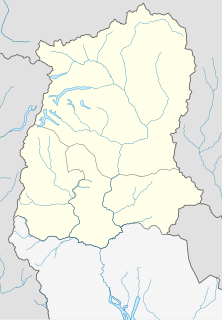
Rumtek Monastery, also called the Dharmachakra Centre, is a gompa located in the Indian state of Sikkim near the capital Gangtok. It is a focal point for the sectarian tensions within the Karma Kagyu school of Tibetan Buddhism that characterize the Karmapa controversy.

West Sikkim is a district of the Indian state of Sikkim. Its capital is Geyzing, also known as Gyalshing. The district is a favourite with trekkers due to the high elevations. Other important towns include Pelling and Yuksom. Local people also call as Pallo- Sikkim and Sano- Sikkim as commonly.
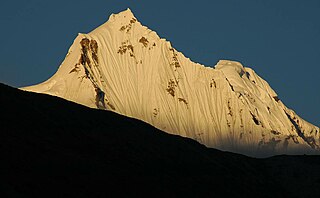
North Sikkim is a district of the Indian state of Sikkim. Its district headquarters is Mangan. It is the seventh least populous district in the country.

Khecheopalri Lake, originally known as Kha-Chot-Palri, is a lake located near Khecheopalri village, 147 kilometres (91 mi) west of Gangtok in the West Sikkim district of the Northeastern Indian state of Sikkim.
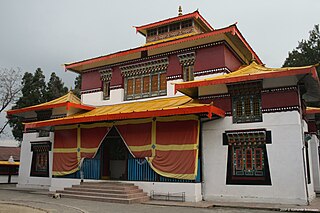
The Enchey Monastery was established in 1909 above Gangtok, the capital city of Sikkim in the Northeastern Indian state. It belongs to the Nyingma order of Vajrayana Buddhism. The monastery built around the then small hamlet of Gangtok became a religious centre. The location was blessed by Lama Drupthob Karpo, a renowned exponent of tantric (adept) art in Buddhism with flying powers; initially a small Gompa was established by him after he flew from Maenam Hill in South Sikkim to this site. The literal meaning of Enchey Monastery is the "Solitary Monastery". Its sacredness is attributed to the belief that Khangchendzonga and Yabdean – the protecting deities – reside in this monastery. As, according to a legend, Guru Padmasambhava had subdued the spirits of the Khangchendzonga, Yabdean and Mahākāla here. In view of this legend, the religious significance of Enchey Monastery is deeply ingrained in every household in Gangtok. It is also believed that these powerful deities always fulfil the wishes of the devotees.

Yuksom is a historical town in Geyzing subdivision of West Sikkim district in the Northeast Indian state of Sikkim. It was the first capital of Sikkim established in 1642 AD by Phuntsog Namgyal who was the first Chogyal of Sikkim. The coronation site of the first monarch of Sikkim is known as the "Throne of Norbugang". Yuksom is where there is the Norbugang Chorten near the Norbugang throne, the place Namgyal was crowned and several monasteries and a lake. The dynastic rule of the Chogyals lasted for 333 years.
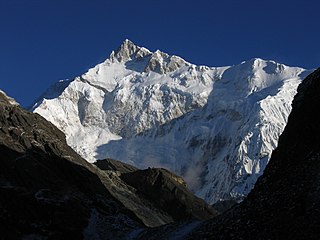
Khangchendzonga National Park also Kanchenjunga Biosphere Reserve is a National Park and a Biosphere reserve located in Sikkim, India. It was inscribed to the UNESCO World Heritage Sites list in July 2016, becoming the first "Mixed Heritage" site of India. The park gets its name from the mountain Kangchenjunga which is 8,586 metres (28,169 ft) tall, the third-highest peak in the world. The total area of this park is 849.5 km2 (328.0 sq mi).

Hee Bermiok is a small town in West Sikkim near Pelling in India. It is known for its mountain biking, nature walks, hiking, excursions, and the traditions and customs of the Limboo, Sherpa, Bhutia, Lepcha, and Nepalis.
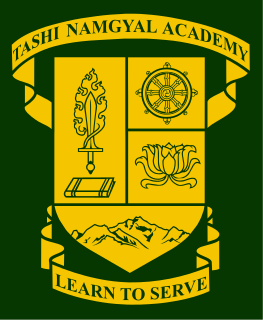
Tashi Namgyal Academy (TNA) is a public school in the Himalayan state of Sikkim in India. It was founded in 1926 by the late Sir Tashi Namgyal, KCSI, KCIE, the 11th consecrated Ruler of Sikkim. It is an autonomous English-medium, co-educational and residential-cum-day school.

Tuljabhavani Temple is a Hindu temple dedicated to the goddess Bhavani. It is located in Tuljapur in Osmanabad district of Maharashtra and is considered as one of the 51 Shakti Pithas. It is situated 45 km from Solapur.The temple was built in c. 12th century CE.
The Sikkim mountain vole is a species of rodent in the family Cricetidae. It is found in Bhutan, India, Nepal and China.

The scarlet finch is a small passerine bird in the finch family Fringillidae. It is found in the Himalayas from Uttarakhand state in the Indian Himalayas eastwards across Nepal, stretching further east to the adjacent hills of Northeast India and Southeast Asia as far south as Thailand. It is resident in the Himalayas, but many birds winter to the immediate south. Its natural habitat is temperate forests.

Tsuklakhang Palace or Tsuklakhang Royal Chapel and Monastery is a Buddhist palacial monastery in Gangtok, Sikkim, India.

Sikkim Mahinda, commonly known as S. Mahinda, was a Buddhist monk from the state of Sikkim. He was a poet and author, and participated in the Sri Lankan independence movement. Although he was from Sikkim, he identified himself as a Tibetan, presumably because it was more well known in Ceylon.
Mun or Munism is the traditional polytheistic, animist, shamanistic, and syncretic religion of the Lepcha people. It predates the seventh century Lepcha conversion to Lamaistic Buddhism, and since that time, the Lepcha have practiced it together with Buddhism. Since the arrival of Christian missionaries in the nineteenth century, Mun traditions have been followed alongside that religion as well. The traditional religion permits incorporation of Buddha and Jesus Christ as deities, depending on household beliefs.

"Lama" Kazi Dawa Samdup is now best known as one of the first translators of important works of Tibetan Buddhism into the English language and a pioneer central to the transmission of Buddhism in the West. From 1910 he also played a significant role in relations between British India and Tibet.

Tendong Dichhen Salhun Gumpa or Tendong Gumpa as commonly known, is situated atop 8530 ft. altitude from mean sea level (msl). This monastery is surrounded by lush green virgin reserve forest and nearest hamlet is Damthang which is at six kilometer walking distance. Because of its seclusion, there are no resident monks/nuns in this monastery.

















